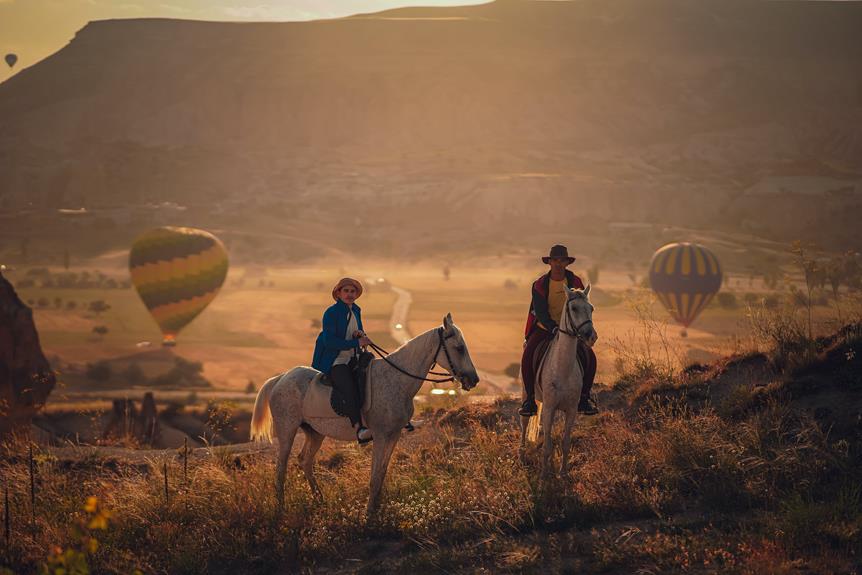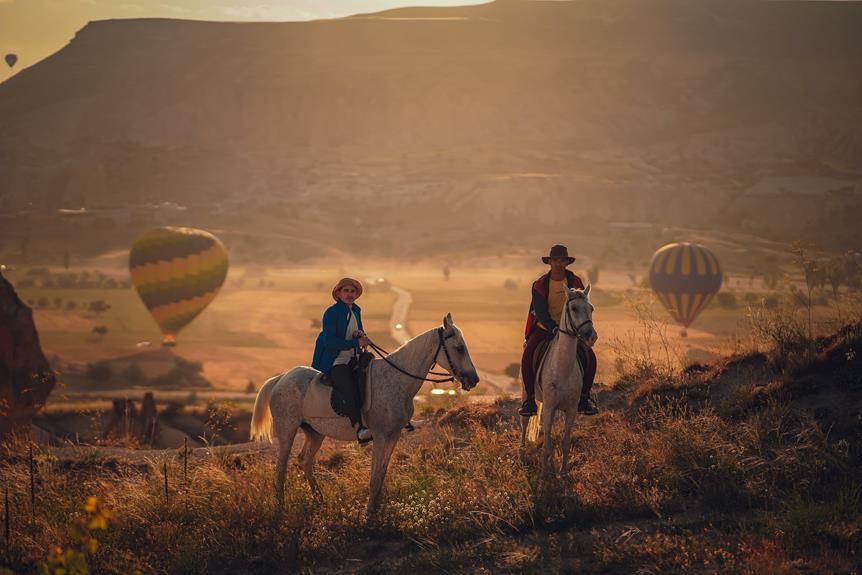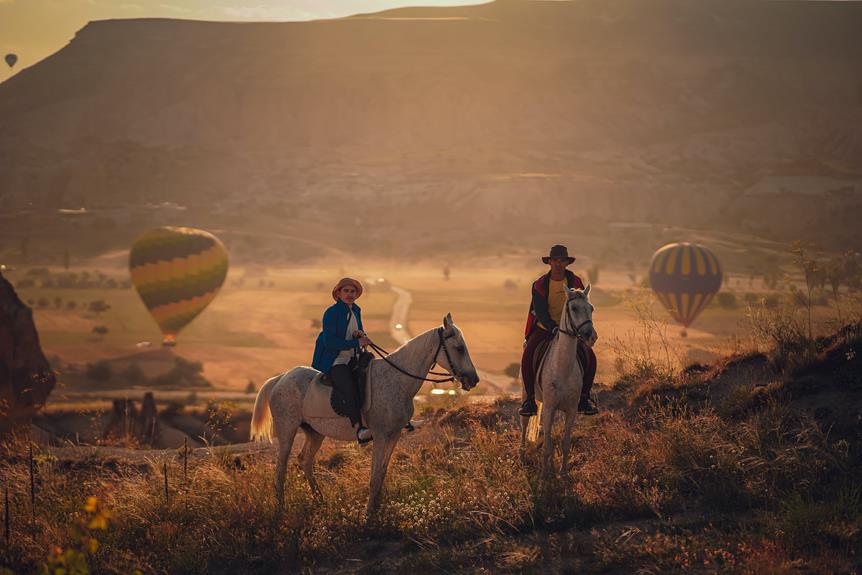Do you ever wonder what wild horses eat to survive in their natural habitats?
Well, picture this: a herd of wild mustangs galloping freely across the open plains, their majestic manes flowing in the wind.
But have you ever stopped to think about what fuels these magnificent creatures?
It turns out that the diet of wild horses is quite fascinating, and it's not as simple as just munching on grass all day.
So, let's dive into the world of wild horse nutrition and explore the various elements that make up their diet.
Key Takeaways
- Wild horses primarily rely on a diverse range of grasses and forage for their dietary needs.
- They also consume wild forbs, tough bushes and shrubs, and other types of vegetation for essential nutrients.
- Wild horses adapt their diet based on the availability of different plant species in their environment.
- Water sources, seasonal variations, and human intervention can impact the natural diet and nutritional requirements of wild horses.
Grasses and Forage
Wild horses primarily rely on a diverse range of grasses and forage to meet their dietary needs. These equines, as managed by the Bureau of Land Management, have evolved to thrive on the natural vegetation found in their habitats. They consume various types of plants, including different species of grasses that grow in abundance. These grasses provide them with the necessary nutrients, such as carbohydrates and fiber, to sustain their energy levels and support their overall health.
In addition to grasses, wild horses also eat wild forbs. These forbs are plants that are rich in vitamins, minerals, and moisture. While they may not be able to sustain the horses on their own, they contribute to their overall diet and provide essential nutrients.
The wild horses may also turn to tough, prickly, and woody bushes and shrubs when other food sources become scarce. These plants, although not as palatable, can serve as a supplemental food source during challenging times.
Furthermore, wild horses have been known to consume wild apples and other fruits when they come across them in the wilderness. These fruits are considered a treat and offer a welcomed change in their diet.
Lastly, in times of scarcity, wild horses may resort to eating certain types of weeds. Although not their preferred food, these weeds can provide them with necessary nutrition to survive.
Shrubs and Vegetation
As we explore the topic of shrubs and vegetation in the wild horse's diet, it's important to understand the role these plants play in their nutrition. Wild horses eat a variety of shrubs, including tough, prickly, and woody types. Although these shrubs are less favored, they're consumed when other options are scarce. Shrubs and vegetation are a crucial part of the wild horse's natural diet, providing essential nutrients and fiber.
In the wild, horses adapt to eating different kinds of vegetation, including shrubs, to sustain themselves when other food sources are limited. While not their preferred choice, wild horses will eat bushes and shrubs if there's a shortage of other available food. These plants serve as a vital component of the natural forage that wild horses rely on for their nutritional needs.
Shrubs and vegetation offer a diverse range of nutrients that wild horses require to maintain their health. They provide essential vitamins, minerals, and antioxidants that support their overall well-being. Additionally, the fiber content in shrubs aids in digestion and helps regulate the wild horse's digestive system.
The ability of wild horses to adapt and consume shrubs and vegetation showcases their resilience and survival instincts in challenging environments. It's a testament to their remarkable ability to find nourishment even in less favorable conditions. Ultimately, shrubs and vegetation play a significant role in the wild horse's diet, ensuring their nutritional needs are met and enabling them to thrive in their natural habitat.
Wild Horse Herbivore Diet
Wild horses derive their nutrition from a diet consisting mainly of grass, weeds, and shrubs found in their natural habitat. As herbivores, wild horses eat a variety of plant materials to meet their nutritional needs. In the American west, where they roam freely, these majestic creatures scavenge for food, relying on the vegetation available to them. However, unlike their domesticated counterparts with cultivated pasture, hay, or pelleted feed, wild horses may not always have access to sufficient nutrients, especially during the harsh winter months.
To compensate for the lower nutritional content of their forage, the diet of wild horses relies on quantity. They spend an average of 16 hours grazing out of every 24, constantly moving to find food. Their ability to consume large quantities of plant material allows them to extract the necessary nutrients from their diet. In addition to grass, weeds, and shrubs, wild horses can also eat fruits, forbs, and certain types of weeds if other food sources are scarce.
Wild horses have adapted to survive on the limited resources available in their natural environment. Their herbivore diet ensures they can obtain the essential nutrients needed for their overall health and well-being. By consuming a variety of plants found in the American west, wild horses are able to maintain their resilience and thrive in their natural habitat.
Natural Feeding Patterns
To understand the natural feeding patterns of wild horses, you must observe their constant movement and utilization of available forage. Wild horses live in diverse habitats, including grasslands, woodlands, and deserts, where they've adapted to find and consume a variety of plant species.
Here are four key aspects of their natural feeding patterns:
- Grazing: Wild horses spend a significant amount of time grazing on grass, the primary component of their diet. They roam vast areas, constantly seeking out new patches of grass to sustain themselves.
- Foraging for Weeds and Shrubs: In addition to grass, wild horses also eat weeds and shrubs that grow in their natural habitat. They've developed a taste for a wide range of plant species, enabling them to meet their nutritional needs.
- Scavenging for Food: Wild horses are opportunistic feeders and use their constant movement to scavenge for food. They rely on their keen senses to locate and consume forage that may be hidden or less accessible.
- Adapting to Available Food Sources: Wild horses are adaptable eaters. They can adjust their diet based on the availability of different plant species, including wild fruits, forbs, and certain weeds. This flexibility allows them to survive in various ecosystems.
Adaptation to Wild Environments
They are masters of adaptation, navigating the rugged landscapes and unforgiving environments of the wild with ease and resilience. Wild horses eat what they can find, such as grass, weeds, and shrubs, showcasing their adaptability to different food sources in their environment. Their grazing habits and constant search for food help them make up for the poorer nutritional content of the forage they find, highlighting their ability to adapt to varying diet conditions.
| Adaptation to Wild Environments |
|---|
| Wild horses spend most of their time with their heads down while eating, a behavior that helps prevent inhalation of dirt, dust, and food, demonstrating their physical adaptation to grazing in the wild. |
| They have also adapted to distinguish between edible and poisonous weeds, which becomes a choice for them when there is a lack of other food sources, showcasing their survival skills. |
| In winter, wild horses paw through snow to locate edible vegetation, demonstrating their adaptation to finding food in harsh conditions. |
Wild horses have honed their abilities to survive in the wild by adapting to their environments. They have developed physical traits, such as grazing with their heads down, to protect themselves from inhaling unwanted substances while feeding. Additionally, their ability to discern between edible and poisonous weeds showcases their adaptability when faced with limited food options. Even in harsh winter conditions, wild horses are able to navigate through snow, using their hooves to uncover edible vegetation. Through these adaptations, wild horses have become resilient and capable of thriving in a variety of wild environments.
Frequently Asked Questions
Do Wild Horses Eat Meat?
No, wild horses do not eat meat. Their dietary preferences consist of grass, weeds, and shrubs. Meat does not play a role in their diet. Throughout evolution, horses have adapted to survive on a plant-based diet.
What Did Horses Eat in the Wild?
Horse grazing habits in the wild vary, influenced by climate and food availability. They primarily eat grass, weeds, and shrubs to survive. Their diet differs from domesticated horses who have cultivated pasture, hay, or pelleted feed.
What Is a Horse's Favorite Food?
Your horse's favorite food depends on its individual preferences. Horses have diverse dietary preferences, but they generally enjoy fresh grass, hay, and grains. It's important to provide a balanced diet to meet their nutritional needs.
Do Wild Horses Just Eat Grass?
Wild horses don't just eat grass. Their diet consists of various plants like grass, weeds, shrubs, and wild fruits. They spend a lot of time grazing to meet their nutritional needs and can scavenge when food is scarce.
Conclusion
So, as you can see, wild horses have a diverse diet consisting of grass, weeds, shrubs, and even fruits. They spend a significant amount of time grazing to meet their nutritional needs, especially in the absence of cultivated pasture or hay.
Their adaptation to wild environments allows them to scavenge for food and rely on quantity to compensate for the lower nutritional content of their forage.
Overall, their diet is a reflection of their natural habitat and the resources available to them.



0 Comments